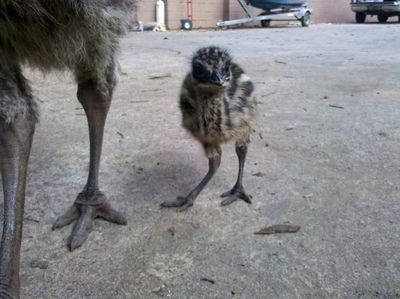from:
http://www.exoticpetvet.net/avian/emus.html
"Chicks are quite hardy and do best when allowed outdoors in large pens that allow them plenty of exercise. Chicks may suffer from leg deformities, the cause of which is usually multifactorial. Splay leg may occur in chicks, and is usually easily corrected if detected early and hobbles are applied to the legs."
from:
http://www.redoakfarm.com/emuchickhealth.htm
"Leg problems:
Splayed legs - the affected leg twists out away from the body, rotating to point the toes to a right angle from the body. Splayed legs appear to be caused by two different things, injury and nutritional deficiencies.
- Injury: crowded pens, slick floor surfaces, getting caught behind watering dishes or feeders. Prevention - lots of room, putting a towel down on the hatcher floor, straw or another material on the chick floors, eliminating 'danger areas' in the pens.
- Nutritional deficiencies in the breeder hen is passed on to the chick. Prevention - feed a balanced breeder ration prior to and during breeding/laying season.
- Nutritional deficiencies caused by rapid or excessive weight loss in eggs during incubation. If an egg is losing weight too fast, put a piece of paper tape over a section and monitor it.
- Nutritional deficiencies in chicks - chicks need a balanced ration in order to develop strong tendons, bones and muscles.
I get several phone calls or emails from site visitors asking if the chick can't be kept alive. In the wild this chick would not be able to keep up and would die early. Even with human intervention it will eventually get so bad that the chick cannot get around. You have a choice, you can prolong it's life by:
- Hand feeding it and watering it several times a day.
- Clean up after it frequently so it is not laying in it's own manure.
- Moved into sunshine during nice weather and under shelter in bad weather.
- Protect from the other emu so they don't peck his eyes out or kill him.
- Dig a larger hole to bury the body when it dies anyway.
Or you can put it down immediately.
Deformed legs: bowed or twisted bones, one leg shorter than the other. etc. This is caused by a deficiency in the B vitamins and if caught early can be treated by changing to a better diet. Some deformity may remain, but the chick can at least be raised to processing weight."
found a video from youtube:
from:
http://www.birdcareco.com/English/Arts/Health arts/Splay/splayed.html
"There are lots of old wives tales told about splayed legs in cage and aviary birds and rotating legs in larger birds like emus and ostriches. Whilst a few instances have medical or environmental causes the majority of cases have calcium at their root. This article is intended to explain how calcium is involved in and how proper calcium supplementation can prevent its occurrence.
We are all aware of the role of calcium in bone formation. In the rapidly growing chick the bones are consuming large quantities of calcium. If the diet is deficient in calcium, or vitamin D3, there may not be enough calcium to go round the whole body. If the nerves and muscles go short of calcium they stop working properly. For nestlings this means that the leg muscles are unable to hold the legs together and support the chick's weight.
For larger birds uneven muscle function tends to cause the leg to twist outwards at the hips until the toes point out sideways.
Leg rotations are virtually impossible to treat.
Calcivet (CalciBoost) will stop the problem getting any worse but is unlikely to reverse the deformity. For splayed legs setting the legs into an appropriate splint and simultaneously treating with Calcivet ( CalciBoost) will normally return the legs to their normal condition if caught early enough."




